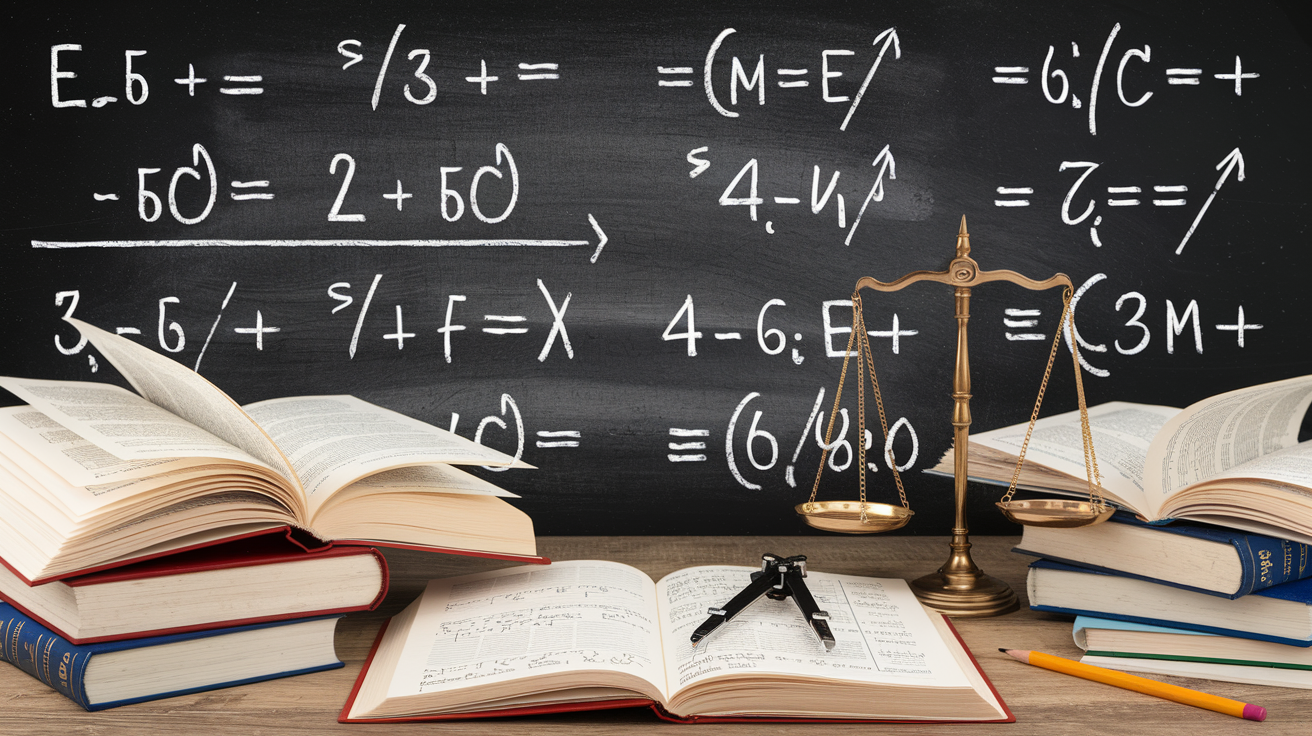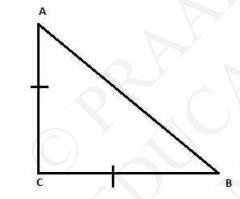6. ABC is an equilateral triangle of side 2a. Find each of its altitudes
Answer
Let AD be the altitude of the given equilateral triangle, \( \triangle \mathrm{ABC} \)We know that altitude bisects the opposite side
\( \mathrm{BD}=\mathrm{DC}=\mathrm{a} \)

In triangle ADB,
\( \angle \mathrm{ADB}=90^{\circ} \)
Using Pythagoras theorem, we get
\( \mathrm{AD}^{2}+\mathrm{DB}^{2}=\mathrm{AB}^{2}\)
\(\mathrm{AD}^{2}+\mathrm{a}^{2}=(2 \mathrm{a})^{2}\)
\(\mathrm{AD}^{2}+\mathrm{a}^{2}=4 \mathrm{a}^{2}\)
\(\mathrm{AD}^{2}=3 \mathrm{a}^{2}\)
\(\mathrm{AD}=\mathrm{a} \sqrt{3} \)
In an equilateral triangle, all the altitudes are equal in length.
Hence, the length of each altitude will be \( \sqrt{3} a \).
7. Prove that the sum of the squares of the sides of a rhombus is equal to the sum of the squares of its diagonals.
Answer
In Rhombus ABCD,\( \mathrm{AB}, \mathrm{BC}, \mathrm{CD} \) and AD are the sides of the rhombus. BD and AC are the diagonals.
To prove: \( \mathrm{AB}^{2}+\mathrm{BC}^{2}+\mathrm{CD}^{2}+\mathrm{AD}^{2}=\mathrm{AC}^{2}+\mathrm{BD}^{2} \)
Proof:
The figure is shown below:
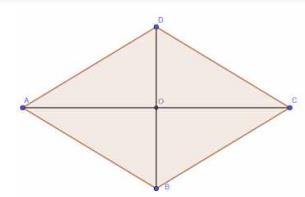
In \( \triangle \mathrm{AOB}, \triangle \mathrm{BOC}, \triangle \mathrm{COD}, \triangle \mathrm{AOD} \),
Applying Pythagoras theorem, we obtain
\( \mathrm{AB}^{2}=\mathrm{AO}^{2}+\mathrm{OB}^{2} \quad\ldots \text{(i)}\)
\(\mathrm{BC}^{2}=\mathrm{BO}^{2}+\mathrm{OC}^{2} \quad\ldots \text{(ii)}\)
\(\mathrm{CD}^{2}=\mathrm{CO}^{2}+\mathrm{OD}^{2} \quad\ldots \text{(iii)}\)
\(\mathrm{AD}^{2}=\mathrm{AO}^{2}+\mathrm{OD}^{2} \quad\ldots \text{(iv)}\)
Now after adding all equations, we get,
\( \mathrm{AB}^{2}+\mathrm{BC}^{2}+\mathrm{CD}^{2}+\mathrm{AD}^{2}=2\left(\mathrm{AO}^{2}+\mathrm{OB}^{2}+\mathrm{OC}^{2}+\mathrm{OD}^{2}\right) \)
Diagonals of a rhombus bisect each other,
Thus \( \mathrm{AO}=\frac{ \mathrm{AC} }{ 2 }, \mathrm{OB}=\frac{ \mathrm{BD} }{ 2 }, \mathrm{OC}=\frac{ \mathrm{AC} }{ 2 } \), and \( \mathrm{OD}=\frac{ \mathrm{BD} }{ 2 } \)
\( A B^{2}+B C^{2}+C D^{2}+A D^{2}=2\)\(\left[\left(\frac{A C}{2}\right)^{2}+\left(\frac{B D}{2}\right)^{2}+\left(\frac{A C}{2}\right)^{2}+\left(\frac{B D}{2}\right)^{2}\right]\)
\(=4\left[\frac{A C^{2}}{4}+\frac{B D^{2}}{4}\right]\)
\(=(\mathrm{AC})^{2}+(\mathrm{BD})^{2} \)
Hence Sum of squares of sides of a rhombus equals to sum of squares of diagonals of rhombus.
8.
(i) In Fig. 6.54, O is a point in the interior of a triangle \( \mathrm{ABC}, \mathrm{OD} \perp \) \( \mathrm{BC}, \mathrm{OE} \perp \mathrm{AC} \) and \( \mathrm{OF} \perp \mathrm{AB} \). Show that
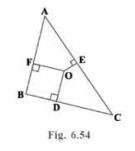
\( \mathrm{OA}^{2}+\mathrm{OB}^{2}+\mathrm{OC}^{2}-\mathrm{OD}^{2}-\mathrm{OE}^{2}-\mathrm{OF}^{2}=\mathrm{AF}^{2}+\mathrm{BD}^{2}+\mathrm{CE}^{2} \)

\( \mathrm{OA}^{2}+\mathrm{OB}^{2}+\mathrm{OC}^{2}-\mathrm{OD}^{2}-\mathrm{OE}^{2}-\mathrm{OF}^{2}=\mathrm{AF}^{2}+\mathrm{BD}^{2}+\mathrm{CE}^{2} \)
Answer
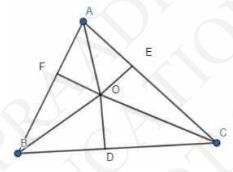
To Prove
\( \mathrm{OA}^{2}+\mathrm{OB}^{2}+\mathrm{OC}^{2}-\mathrm{OD}^{2}-\mathrm{OE}^{2}-\mathrm{OF}^{2}=\mathrm{AF}^{2}+\mathrm{BD}^{2}+\mathrm{EC}^{2} \)
Given: \( \mathrm{OD}, \mathrm{OE} \) and OF are perpendiculars on sides \( \mathrm{BC}, \mathrm{AC} \) and AB respectively
Construction : Join OA, OB and OC
Now according to pythagoras theorem, In a right angled triangle, (hypotenuse)\( ^{2}=(\text { altitude})^{2}+(\text { base})^{2} \)
Applying Pythagoras theorem in \( \triangle \mathrm{AOF} \), we obtain
\( \mathrm{OA}^{2}=\mathrm{OF}^{2}+\mathrm{AF}^{2} \quad\ldots \text{(i)}\)
Similarly, in \( \triangle \mathrm{BOD} \),
\( \mathrm{OB}^{2}=\mathrm{OD}^{2}+\mathrm{BD}^{2} \quad\ldots \text{(ii)}\)
Similarly, in \( \triangle \mathrm{COE} \),
\( \mathrm{OC}^{2}=\mathrm{OE}^{2}+\mathrm{EC}^{2} \quad\ldots \text{(iii)}\)
Adding these equations, we get
\( \mathrm{OA}^{2}+\mathrm{OB}^{2}+\mathrm{OC}^{2}=\mathrm{OF}^{2}+\mathrm{AF}^{2}+\mathrm{OD}^{2}+\mathrm{BD}^{2}+\mathrm{OE}^{2}+\mathrm{EC}^{2} \)
Rearranging the equations we get,
\( \mathrm{OA}^{2}+\mathrm{OB}^{2}+\mathrm{OC}^{2}-\mathrm{OD}^{2}-\mathrm{OE}^{2}-\mathrm{OF}^{2}=\mathrm{AF}^{2}+\mathrm{BD}^{2}+\mathrm{EC}^{2} \)
Hence, Proved
(ii) In Fig. 6.54, O is a point in the interior of a triangle \( \mathrm{ABC}, \mathrm{OD} \perp \) \( \mathrm{BC}, \mathrm{OE} \perp \mathrm{AC} \) and \( \mathrm{OF} \perp \mathrm{AB} \). Show that

\( \mathrm{AF}^{2}+\mathrm{BD}^{2}+\mathrm{CE}^{2}=\mathrm{AE}^{2}+\mathrm{CD}^{2}+\mathrm{BF}^{2} \)

\( \mathrm{AF}^{2}+\mathrm{BD}^{2}+\mathrm{CE}^{2}=\mathrm{AE}^{2}+\mathrm{CD}^{2}+\mathrm{BF}^{2} \)
Answer
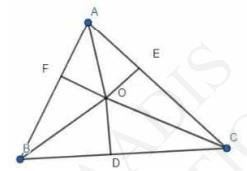
To Prove: \( \mathrm{AF}^{2}+\mathrm{BD}^{2}+\mathrm{EC}^{2}=\mathrm{AE}^{2}+\mathrm{CD}^{2}+\mathrm{BF}^{2} \)
From the above given result from (i),
\( \mathrm{AF}^{2}+\mathrm{BD}^{2}+\mathrm{EC}^{2}\)
\(=\left(\mathrm{AO}^{2}-\mathrm{OE}^{2}\right)+\left(\mathrm{OC}^{2}-\mathrm{OD}^{2}\right)+\left(\mathrm{OB}^{2}-\mathrm{OF}^{2}\right) \)
and from eq(i), (ii) and (iii)
\( \mathrm{AO}^{2}-\mathrm{OE}^{2}=\mathrm{AE}^{2}, \mathrm{OC}^{2}-\mathrm{OD}^{2}=\mathrm{CD}^{2}, \mathrm{OB}^{2}-\mathrm{OF}^{2}-\mathrm{BF}^{2} \)
Putting these values in above equation we get,
\( \mathrm{AF}^{2}+\mathrm{BD}^{2}+\mathrm{EC}^{2}=\mathrm{AE}^{2}+\mathrm{CD}^{2}+\mathrm{BF}^{2} \)
Hence, Proved
NCERT Math Solutions for Class 10 Maths Chapter 6 Triangle(English Medium) || CBSE Class 10 Maths Chapter 6 Triangle Ex 6.5
Download the Math Ninja App Now
9. A ladder 10 m long reaches a window 8 m above the ground. Find the distance of the foot of the ladder from base of the wall
Answer
Let OA be the wall and AB be the ladder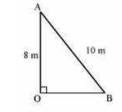
By Pythagoras theorem, \( \mathrm{AB}^{2}=\mathrm{OA}^{2}+\mathrm{BO}^{2} \)
\( (10)^{2}=(8)^{2}+\mathrm{OB}^{2}\)
\(100=64+\mathrm{OB}^{2}\)
\(\mathrm{OB}^{2}=36\)
\(\mathrm{OB}=6 \mathrm{~cm} \)
Therefore, the distance of the foot of the ladder from the base of the wall is 6 m .
10. A wire attached to a vertical pole of height 18 m is 24 m long and has a stack attached to the other end. How far from the base of the pole should the stack be driven so that the wire will be taut?
Answer
To find: OALet OB be the pole and AB be the wire
By Pythagoras theorem,
Pythagoras Theorem: the square of the hypotenuse (the side opposite the right angle) is equal to the sum of the squares of the other two sides.

\( \mathrm{AB}^{2}=\mathrm{OB}^{2}+\mathrm{OA}^{2} \)
\( (24)^{2}=(18)^{2}+\mathrm{OA}^{2} \)
\( \mathrm{OA}^{2}=(576-324) \)
\( \mathrm{OA}^{2}=252 \)
\( \mathrm{OA}=6 \sqrt{7 } \mathrm{~m} \)
11. An aeroplane leaves an airport and flies due north at a speed of 1000 km per hour. At the same time, another aeroplane leaves the same airport and flies due west at a speed of 1200 km per hour. How far apart will be the two planes after \( 1 \frac{1}{2} \) hours?
Answer

we know, Distance \( = \) speed \( \times \) time Distance traveled by the plane flying towards north in \( 1 \frac{1}{2} h r s=1,000 \times 1 \frac{1}{2} \) \( =1,500 \mathrm{~km} \)
Similarly, distance traveled by the plane flying towards west in \(1 \frac{1}{2} h r s=1,200 \times 1 \frac{1}{2}\)
\(=1,800 \mathrm{~km} \)
Let these distances be represented by OA and OB respectively.
Pythagoras Theorem: It states that the square of the hypotenuse (the side opposite the right angle) is equal to the sum of the squares of the other two sides.
Applying Pythagoras theorem,
\(\mathrm{AB}^{2}=\mathrm{OA}^{2}+\mathrm{OB}^{2}\)
\(A B=\sqrt{O A^{2}+O B^{2}}\)
\(A B=\sqrt{(1500)^{2}+(1800)^{2}}\)
\(A B=\sqrt{2250000+3240000}\)
\(A B=\sqrt{5490000}\)
\(A B=300 \sqrt{61} \)
Distances between planes is \( 300 \sqrt{6} 1 \mathrm{~km} \).
NCERT Math Solutions for Class 10 Maths Chapter 6 Triangle(English Medium) || CBSE Class 10 Maths Chapter 6 Triangle Ex 6.5
Download the Math Ninja App Now12. Two poles of heights 6 m and 11 m stand on aplane ground. If the distance between the feet of the poles is 12 m , find the distance between their tops
Answer
Let CD and \( A B \) be the poles of height 11 m and 6 m Therefore, \( \mathrm{CP}=11-6=5 \mathrm{~m} \)From the figure, it can be observed that \( \mathrm{AP}=12 \mathrm{~m} \) Applying Pythagoras theorem for \( \triangle \mathrm{APC} \), we obtain

\( \mathrm{AP}^{2}+\mathrm{PC}^{2}=\mathrm{AC}^{2}\)
\((12)^{2}+(5)^{2}=\mathrm{AC}^{2}\)
\(\mathrm{AC}^{2}=(144+25)\)
\(\mathrm{AC}^{2}=169\)
\(\mathrm{AC}=13 \mathrm{~m} \)
Therefore, the distance between their tops is 13 m
13. D and E are points on the sides CA and CB respectively of a triangle ABC right angled at C . Prove that \( \mathrm{AE}^{2}+\mathrm{BD}^{2}=\mathrm{AB}^{2}+\mathrm{DE}^{2} \)
Answer
Prove: \( \mathrm{AE}^{2}+\mathrm{BD}^{2}=\mathrm{AB}^{2}+\mathrm{DE}^{2} \)Given: D and E are midpoints of AD and CB and ABC is right angled at C
Applying Pythagoras theorem in \( \triangle \mathrm{ACE} \), we obtain
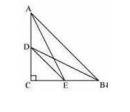
Pythagoras theorem: It states that the square of the hypotenuse (the side opposite the right angle) is equal to the sum of the squares of the other two sides.
\( \mathrm{AC}^{2}+\mathrm{CE}^{2}=\mathrm{AE}^{2} \quad\ldots \text{(i)}\)
Applying Pythagoras theorem in triangle BCD , we get
\( \mathrm{BC}^{2}+\mathrm{CD}^{2}=\mathrm{BD}^{2} \quad\ldots \text{(ii)}\)
Adding equations (i) and (ii), we get
\( \mathrm{AC}^{2}+\mathrm{CE}^{2}+\mathrm{BC}^{2}+\mathrm{CD}^{2}=\mathrm{AE}^{2}+\mathrm{BD}^{2} \quad\ldots \text{(iii)}\)
Applying Pythagoras theorem in triangle CDE, we get
\( \mathrm{DE}^{2}=\mathrm{CD}^{2}+\mathrm{CE}^{2} \)
Applying Pythagoras in triangle ABC , we get
\( \mathrm{AB}^{2}=\mathrm{AC}^{2}+\mathrm{CB}^{2} \)
Putting these values in eqn(iii), we get
\( \mathrm{DE}^{2}+\mathrm{AB}^{2}=\mathrm{AE}^{2}+\mathrm{BD}^{2} \)
Hence, Proved.
14. The perpendicular from \( A \) on side \( B C \) of a \( \triangle A B C \) intersects \( B C \) at D such that \( \mathrm{DB}=3 \mathrm{CD} \) (see Fig. 6.55). Prove that \( 2 \mathrm{AB}^{2}=2 \mathrm{AC}^{2}+ \) \( \mathrm{BC}^{2} \)
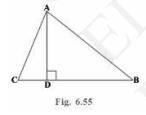

Answer
We have two right angled triangles now \( \triangle \mathrm{ACD} \) and \( \triangle \mathrm{ABD} \)Applying Pythagoras theorem for \( \triangle \mathrm{ACD} \), we obtain
\( \mathrm{AC}^{2}=\mathrm{AD}^{2}+\mathrm{DC}^{2} \)
\( \mathrm{AD}^{2}=\mathrm{AC}^{2}-\mathrm{DC}^{2}\quad\ldots \text{(i)}\)
Applying Pythagoras theorem in \( \triangle \mathrm{ABD} \), we obtain
\( \mathrm{AB}^{2}=\mathrm{AD}^{2}+\mathrm{DB}^{2} \)
\( \mathrm{AD}^{2}=\mathrm{AB}^{2}-\mathrm{DB}^{2} \quad\ldots \text{(ii)}\)
Now we can see from equation \( i \) and equation ii that LHS is
same. Thus,
From (i) and (ii), we get
\( \mathrm{AC}^{2}-\mathrm{DC}^{2}=\mathrm{AB}^{2}-\mathrm{DB}^{2} \quad\ldots \text{(iii)}\)
It is given that \( 3 \mathrm{DC}=\mathrm{DB} \)
Therefore,
\( \mathrm{DC}+\mathrm{DB}=\mathrm{BC} \)
\( \mathrm{DC}+3 \mathrm{DC}=\mathrm{BC} \)
\( 4 \mathrm{DC}=\mathrm{BC} \quad\ldots \text{(iv)}\) and also, \( \mathrm{DC}=\frac{\mathrm{DB} }{ 3} \) putting this in eq (iii) \( \mathrm{DB}=\frac{3 B C}{4} \)
So,
\( D C=\frac{B C}{4} \) and \( D B=\frac{3 B C}{4} \)
Putting these values in (iii), we get
\( A C^{2}-\left(\frac{B C}{4}\right)^{2}=A B^{2}-\left(\frac{3 B C}{4}\right)^{2}\)
\(A C^{2}-B C \times \frac{B C}{16}=A B^{2}-\frac{9 \times B C \times B C}{16}\)
\(16 \mathrm{AC}^{2}-\mathrm{BC}^{2}=16 \mathrm{AB}^{2}-9 \mathrm{BC}^{2}\)
\(16 \mathrm{AB}^{2}-16 \mathrm{AC}^{2}=8 \mathrm{BC}^{2}\)
\(2 \mathrm{AB}^{2}=2 \mathrm{AC}^{2}+\mathrm{BC}^{2} \)
15. In an equilateral triangle \( A B C, D \) is a point on side \( B C \) such that \( B D=\frac{1}{3} B C \) Prove that \( 9 \mathrm{AD}^{2}=7 \mathrm{AB}^{2} \)
Answer
The figure is given below: 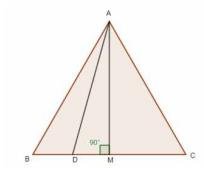
Given: \( \mathrm{B D}=\frac{ \mathrm{B C} }{ 3 } \)
To Prove: \( 9 \mathrm{AD}^{2}=7 \mathrm{AB}^{2} \)
Proof:
Let the side of the equilateral triangle be \( a \), and AM be the altitude of \( \triangle \mathrm{ABC} \)
\( \mathrm{BM}=\mathrm{MC}=\frac{ \mathrm{BC} }{ 2 }=\frac{ \mathrm{a} }{ 2 }\) \(\quad\) [Altitude of an equilateral triangle bisect the side]
And, then, in \( \triangle \mathrm{ABM} \), by pythagoras theorem we write, Pythagoras Theorem : Square of the Hypotenuse equals to the sum of the squares of other two sides.
\( \mathrm{AM}^{2}=\mathrm{AB}^{2}-\mathrm{BM}^{2}\)
\(\text {or } \mathrm{AM}^{2}=\mathrm{a}^{2}-\frac{ \mathrm{a}^{2} }{ 4 }\)
\(A M^{2}=\frac{4 a^{2}-a^{2}}{4}=\frac{3 a^{2}}{4}\)
\(A M=\frac{a \sqrt{3}}{2}\)
\(\mathrm{BD}=\frac{ \mathrm{a} }{ 3 }\) \(\quad\) [\(BC=a\)]
\(\mathrm{DM}=\mathrm{BM}-\mathrm{BD}\)
\(=\frac{ \mathrm{a} }{ 2 }-\frac{ \mathrm{a} }{ 3 }\)
\(=\frac{ \mathrm{a} }{ 6 } \)
According to pythagoras theorem in a right angled triangle, \( (\text {hypotenuse})^{2}=(\text {altitude})^{2}+(\text {base})^{2} \)
Applying Pythagoras theorem in \( \triangle \mathrm{ADM} \), we obtain \( \mathrm{AD}^{2}=\mathrm{AM}^{2}+\mathrm{DM}^{2}\)
\(A D^{2}=\left(\frac{a \sqrt{3}}{2}\right)^{2}+\left(\frac{a}{6}\right)^{2}\)
\(A D^{2}=\frac{3 a^{2}}{4}+\frac{a^{2}}{36}\)
\(A D^{2}=\frac{27 a^{2}+a^{2}}{36}\)
\(A D^{2}=\frac{28 a^{2}}{36} \)
Now, \( \mathrm{a}=\mathrm{AB} \) or \( \mathrm{a}^{2}=\mathrm{AB}^{2} \)
\( A D^{2}=\frac{28 A B^{2}}{36}\)
\(36 \mathrm{AD}^{2}=28 \mathrm{AB}^{2}\)
\(9 \mathrm{AD}^{2}=7 \mathrm{AB}^{2} \)
Hence, Proved.
NCERT Math Solutions for Class 10 Maths Chapter 6 Triangle(English Medium) || CBSE Class 10 Maths Chapter 6 Triangle Ex 6.5
Download the Math Ninja App Now
16. In an equilateral triangle, prove that three times the square of one side is equal to four times the square of one of its altitudes
Answer
Let the side of the equilateral triangle be a, and AE be the altitude of \( \triangle \mathrm{ABC} \)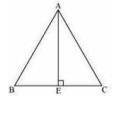
To Prove: \( 4 \times( \)Square of altitude\( )=3 \times( \)Square of one side\( ) \)
Proof:
Altitude of equilateral triangle divides the side in two equal parts.
Therefore,
\( B E=E C=\frac{B C}{2}=\frac{a}{2} \)
Pythagoras Theorem: It states that the square of the hypotenuse (the side opposite the right angle) is equal to the sum of the squares of the other two sides.
Applying Pythagoras theorem in \( \triangle \mathrm{ABE} \), we obtain
\( \mathrm{AB}^{2}=\mathrm{AE}^{2}+\mathrm{BE}^{2}\)
\(a^{2}=A E^{2}+\frac{a^{2}}{4}\)
\(A E^{2}=a^{2}-\frac{a^{2}}{4}\)
\(A E^{2}=\frac{3 a^{2}}{4}\)
\(A E=\frac{\sqrt{3} a}{2}\)
\(4 \times A E^{2}=3 \times a^{2} \)
\( 4 \times( \)Square of altitude \( )=3 \times( \)Square of one side\( ) \)
17. Tick the correct answer and justify:
In \( \triangle \mathrm{ABC}, \mathrm{AB}=6 \sqrt{3} \mathrm{~cm}, \mathrm{AC}=12 \mathrm{~cm} \) and \( \mathrm{BC}=6 \mathrm{~cm} \), the angle B is:
A. \( 120^{\circ} \) B. \( 60^{\circ} \)
C. \( 90^{\circ} \) D. \( 45^{\circ} \)
In \( \triangle \mathrm{ABC}, \mathrm{AB}=6 \sqrt{3} \mathrm{~cm}, \mathrm{AC}=12 \mathrm{~cm} \) and \( \mathrm{BC}=6 \mathrm{~cm} \), the angle B is:
A. \( 120^{\circ} \) B. \( 60^{\circ} \)
C. \( 90^{\circ} \) D. \( 45^{\circ} \)
Answer

Given that, \( \mathrm{AB}=6 \sqrt{3} \mathrm{~cm} \),
\( \mathrm{AC}=12 \mathrm{~cm} \),
And \( \mathrm{BC}=6 \mathrm{~cm} \)
It can be observed that
\( \mathrm{AB}^{2}=108\)
\(\mathrm{AC}^{2}=144 \)
And, \( \mathrm{BC}^{2}=36 \)
\( \mathrm{AB}^{2}+\mathrm{BC}^{2}=\mathrm{AC}^{2} \)
Pythagoras Theorem: It states that the square of the hypotenuse (the side opposite the right angle) is equal to the sum of the squares of the other two sides.
\( \triangle \mathrm{ABC} \), is satisfying Pythagoras theorem.
Therefore, the triangle is a right triangle, right-angled at B
\( \angle \mathrm{B}=90^{\circ} \)
Hence, the correct answer is (C).
NCERT Math Solutions for Class 10 Maths Chapter 6 Triangle(English Medium) || CBSE Class 10 Maths Chapter 6 Triangle Ex 6.5
Download the Math Ninja App NowCentral Board of Secondary Education Official Site
Class 10 : NCERT Solutions for Class 10 Maths Chapter 1 Exercise 1.1
Class 10 : NCERT Solutions for Class 10 Maths Chapter 1 Exercise 1.2
Class 10 : NCERT Solutions for Class 10 Maths Chapter 1 Exercise 1.3
Class 10 : CBSE Class 10 Maths Chapter 2 Polynomials Ex 2.1
Class 10 : CBSE Class 10 Maths Chapter 2 Polynomials Ex 2.2
Class 10 : CBSE Class 10 Maths Chapter 2 Polynomials Ex 2.4
Class 10 : CBSE Class 10 Maths Chapter 3 Pair of Linear Equations in Two Variables Ex 3.1
Class 10 : CBSE Class 10 Maths Chapter 3: Pair of Linear Equations in Two Variables || CBSE Class 10 Maths Chapter 3 Pair of Linear Equations in Two Variables solutions Ex 3.2
Class 10 : CBSE Class 10 Maths Chapter 3: Pair of Linear Equations in Two Variables || CBSE Class 10 Maths Chapter 3 Pair of Linear Equations in Two Variables solutions Ex 3.3
Class 10 : CBSE Class 10 Maths Chapter 3: Pair of Linear Equations in Two Variables || CBSE Class 10 Maths Chapter 3 Pair of Linear Equations in Two Variables solutions Ex 3.4
Class 10 : CBSE Class 10 Maths Chapter 3: Pair of Linear Equations in Two Variables || CBSE Class 10 Maths Chapter 3 Pair of Linear Equations in Two Variables solutions Ex 3.5
Class 10 : CBSE Class 10 Maths Chapter 3: Pair of Linear Equations in Two Variables || CBSE Class 10 Maths Chapter 3 Pair of Linear Equations in Two Variables solutions Ex 3.6
Class 10 : CBSE Class 10 Maths Chapter 4 Quadratic Equations Ex 4.1 || NCERT Solutions for Class 10 Maths Chapter 4: Quadratic Equations (English Medium)
Class 10 : CBSE Class 10 Maths Chapter 4 Quadratic Equations Ex 4.2 || NCERT Solutions for Class 10 Maths Chapter 4: Quadratic Equations (English Medium)
Class 10 : CBSE Class 10 Maths Chapter 4 Quadratic Equations Ex 4.3 || NCERT Solutions for Class 10 Maths Chapter 4: Quadratic Equations (English Medium)
Class 10 : CBSE Class 10 Maths Chapter 5 Arithmetic Progressions Ex 5.1
Class 10 : CBSE Class 10 Maths Chapter 5 Arithmetic Progressions Ex 5.2
Class 10 : CBSE Class 10 Maths Chapter 5 Arithmetic Progressions Ex 5.3
Class 10 : NCERT Math Solutions for Class 10 Maths Chapter 6 Triangle(English Medium) || CBSE Class 10 Maths Chapter 6 Triangle Ex 6.1
Class 10 : NCERT Math Solutions for Class 10 Maths Chapter 6 Triangle(English Medium) || CBSE Class 10 Maths Chapter 6 Triangle Ex 6.2
Class 10 : NCERT Solutions for Class 10 Maths Chapter 8 Exercise 8.2
Class 10 : CBSE Class 10 Maths Chapter 10 Circles solutions Ex 10.2
Class 10 : CBSE Class 10 Maths Chapter 13 Surface Areas and Volumes solutions Ex 13.2
